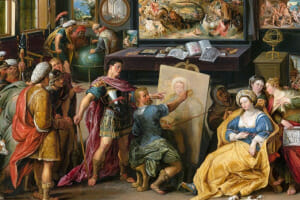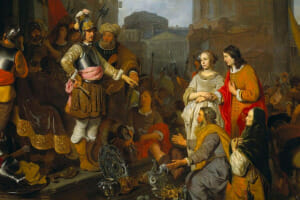Sthenelus of Mycenae: The Stories of the Two Characters Who Bore the Name
 Sthenelus of Mycenae was the son of Perseus and Andromeda, a princess of the Ethiopian king Cepheus and his wife Cassiopeia. He became king of Mycenae after his elder brother, who had succeeded their father, died.
Sthenelus of Mycenae was the son of Perseus and Andromeda, a princess of the Ethiopian king Cepheus and his wife Cassiopeia. He became king of Mycenae after his elder brother, who had succeeded their father, died.
Sthenelus of Achaea was a commander who died in the Trojan war. Discover the myth of Sthenelus from Mycenae and Sthenelus from Achaea.
Sthenelus of Mycenae
The Family
Sthenelus married Niccipe, the daughter of the King of Pisa, and had three children with her; Eurystheus, Alcyone and Astymedusa. Sthenelus was the brother of Perses, Alcaeus, Heleus, Cynurus, Gorgophone, Electryon, Mestor and Autochthe.
Sthenelus’ father, Perseus, was the founder of Mycenae and was popular for slaying the slaying beasts. One of the beasts he slew was Gorgon Medusa who had venomous snakes in place of her hair and turned anyone who gazed into her eyes into stone.
Perseus also killed the sea monster Cetus and saved Andromeda whom she later married and gave birth to Sthenelus. Sthenelus was also the grandson of Zeus, through Perseus, and the Argive princess, Danae.
Sthenleus also shares a kinship with Heracles as his father, Perseus, was the great-grandfather of the Heracles. His grandmother, Danae, was also credited with founding the city of Ardea in Rome.
The Mythology
 Sthenelus is best remembered for exiling his nephew, Amphitryon, after he killed his brother and king of Mycenae, Electryon. There are varying tales about how Amphitryon killed Sthenelus’ brother but the most popular one goes this way.
Sthenelus is best remembered for exiling his nephew, Amphitryon, after he killed his brother and king of Mycenae, Electryon. There are varying tales about how Amphitryon killed Sthenelus’ brother but the most popular one goes this way.
Electryon, king of Tyrins, had just returned from war with some loot which included cattle. Amphitryon, who was married to Electryon’s daughter, Alcmene, was overseeing the cattle with his father-in-law when all of a sudden one of the animals broke out of the herd.
According to Greek mythology, Amphitryon threw a club at the animal in a bid to make it return to its fold. Unfortunately, the club ricocheted off the horns of the animal and went straight to hit the head of Electryon, killing him instantly.
This angered Sthenelus who drove Amphitryon out of Mycenae forcing him to flee to Thebes with his wife Alcmene. The King of Thebes, Creon, then cleansed Amphitryon of the guilt of murdering his father-in-law.
Meanwhile, Sthenelus took over the reins of the kingdom of Mycenae from his deceased brother, Electryon. After the death of Sthenelus, his eldest son, Eurystheus, succeeded him and was responsible for imposing the Twelve Labors on Heracles. Eurystheus was later killed by Hyllus after he attacked Hyllus and his brothers in Athens.
However, there is different evidence from other versions that narrate how Eurystheus died in the battle involving him against Hyllus and his brothers but do not specify at whose hands he died.
Sthenelus of Achaea
Sthenelus in the Iliad
Sthenelus Iliad, also known as Sthenelus of Achaea, was part of the commanders that led the expedition to Troy to back the kidnapped Helen of Sparta. As part of his contribution to the Trojan War, Sthenelus brought 25 ships and he fought with the Argives.
He was great friends with Diomedes and the two ruled the divided land of Iphis and Argos together with Sthenelus ruling the former and Diomedes the latter. According to the Iliad, he was insulted by Agamemnon but Diomedes advised him to keep his calm which he did.
The two warriors fought alongside each other indicating their close relationship. During the latter stages of the war, he was chosen as one of the elite soldiers to enter the Trojan horse. Sthenelus was also part of the Greek army that survived the Trojan war and helped to return Helen.
He was the son of the famous Achaean warrior Capaneus and his wife Evadne. Capaneus had a huge body frame and immense strength which made him so proud and arrogant that he challenged Zeus.
During the war against Thebes, Zeus struck him with a thunderbolt killing him instantly while he was climbing a ladder to scale the Theban wall. At his funeral, Sthenelus’ mother, Evadne, threw herself into the funeral pyre of Capaneus as she couldn’t contain the loss and she died.
Sthenelus and the sons of the Greek commanders who died in the war decided to avenge the death of their fathers. After ten years, they attacked Thebes once again and this time they brought the city to its knees.
The Meaning and How to Pronounce It
Sthenelus means the strong one or an enforcer from the ancient Greek word “Sthenolos“. The Sthenelus pronunciation is as follows: S-thi-ne-lus
The name is a derivate of the Greek word Sthenos which means might, strength, or force.
Since there is little information about Sthenelus, we can’t tell why the Greek mythographers gave him that name. It would also be impossible to tell whether he lived up to the meaning of his name or not.
Conclusion
 In this article, we’ve looked at the myth of Sthenelus from Mycenae and Sthenelus of Achaea and their families, roles and accomplishment in Greek mythology. Here is a summary of all that we’ve read so far:
In this article, we’ve looked at the myth of Sthenelus from Mycenae and Sthenelus of Achaea and their families, roles and accomplishment in Greek mythology. Here is a summary of all that we’ve read so far:
- Sthenelus from Mycenae was the son of Perseus, founder of the same city, and Princess Andromeda of Ethiopia.
- He exiled Amphitryon after Amphitryon accidentally killed Sthenelus’ brother, Electryon, who was the king of Mycenae.
- After exiling Amphitryon, Sthneleus became king of Mycenae and was later succeeded by his son Eurystheus; the same who gave Heracles his Twelve Labors.
- Sthenenlus in the Iliad was from Achaea and the son of the great warrior Capaneus who died after he was struck by a thunderbolt from Zeus for challenging him.
- Sthenelus was known as a skillful and brave soldier who contributed 25 ships to Greece during the Trojan War and helped to return the abducted Helen to her rightful husband.
Both Sthenelus from Mycenae and Sthenelus of Achaea epitomize strength and power as the meaning of their name suggests. However, Sthenelus of Achaea is the most popular for his contributions to the defeat of Troy and the return of Helen to Menelaus, the King of Sparta.

